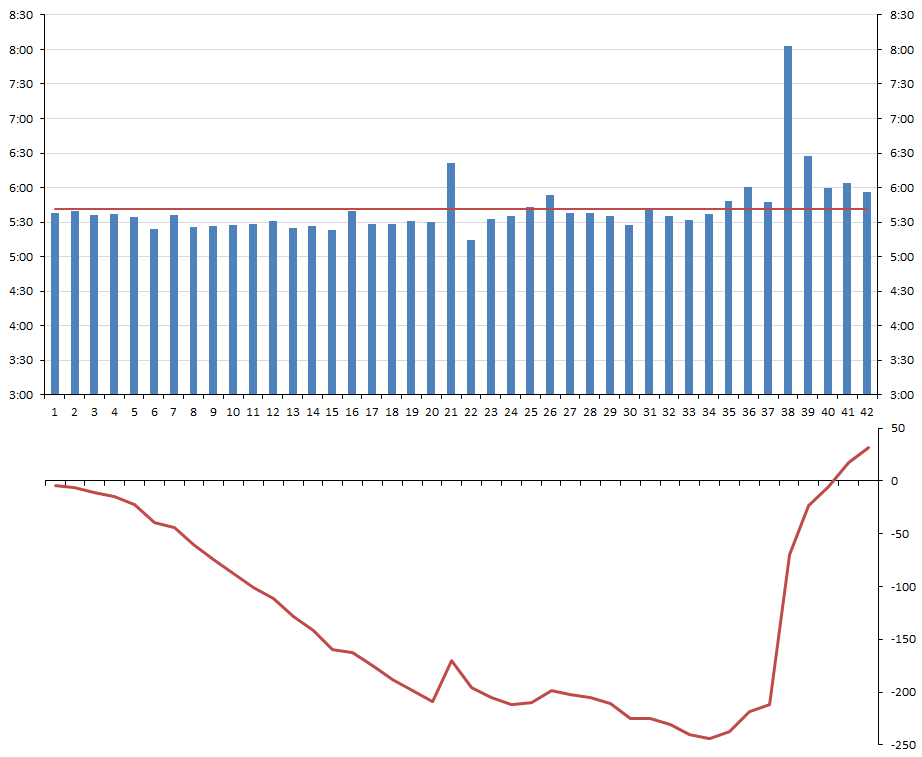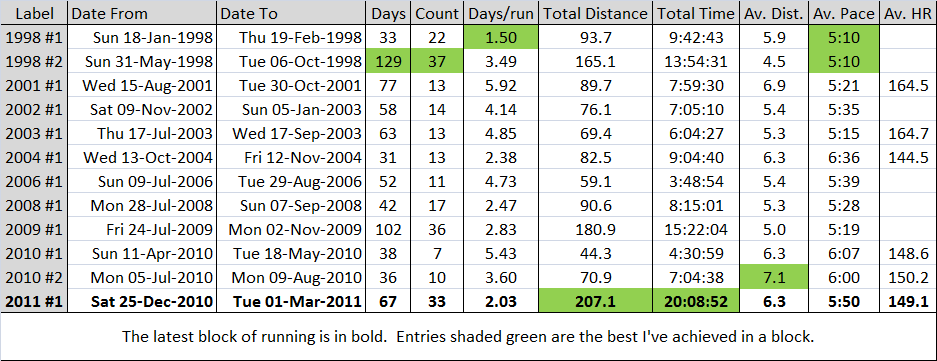On Sunday the 3rd of May, 2015 (two weeks before I officially turn old), I finally achieved a life-long ambition of running a marathon. I ran in the Prague Marathon organised by RunCzech. My official race time was 4:08:02, but since it took me over five minutes to cross the start line, my actual time was 4:02:24.
My training was not particularly rigorous — the longest I had run beforehand was 27km (about 16.5 miles) — and I was really only aiming to finish, so to finish so close to four hours is incredibly gratifying. I spent the vast majority of the race ahead of the 4-hour pace setters, but hit my own version of the wall in the 38th kilometre. These two charts summarise my experience. The first chart lists my times for each kilometre, with the red line being the rate needed to achieve four hours (the peak in the 21st km is a pee break). The second gives my time relative to that 4-hour target (in seconds). At the 34km mark, I was 244 seconds (4 minutes, 4 seconds) ahead of the 4-hour pace, meaning that I lost roughly six and a half minutes in the last 8.2 km.

The biggest thing I learned from the experience is that there is no such thing as “the” wall — there are at least three walls!
The first wall is simple glycogen depletion, possibly combined with dehydration. I’m pretty sure this was not an issue for me, although I am starting to wonder (see below). I had stuffed my face with pasta (and protein) for days beforehand, I downed a Clif Bar immediately prior to the race and I was munching on a Clif Shot Blok every 5km. I was also drinking water regularly, to the point of needing to stop to pee at the half-way mark. Having said that, I now realise that I was only consuming about 20g of carbs per hour, which is considerably less than the commonly recommended 40-60g. I never experienced any of the usual glycogen depletion symptoms, like a brain fade, though. I always felt like I had energy.
The second wall is psychological. Since my longest ever run beforehand was only 27 km, I was acutely aware of the distance once I headed north of 25km and had to talk my way through it in the 28-30 km range. Certainly once I’d gotten to 32 km and was able to tell myself “10 km to go”, this issue seemed to pass completely.
The third wall, which I had not considered at all beforehand, was a dramatic emergence of muscle pain in my quads from about 35km onwards. At first, it just felt like muscle burn from doing hill sprints, but it got worse and just after the 37km mark it became so bad that I had to stop and walk. I tried stretching, but that somehow only made it worse, into a blinding pain that shut out almost all other sensory experience.
I walked and occasionally shuffle-jogged for the next 2km before the pain started to ease and I was able, with a grit-the-teeth-and-focus-like-a-goddamn-laser sort of effort, to keep myself jogging constantly for the final 3 km. Watching the 4-hour pace setters run past me while I was walking was not a pleasant experience.
It was not a pulled muscle (a muscle strain) — it was in both legs and it eased over the next couple of days as I recovered in ways that a strain would not. I also do not think it was glycogen depletion, as I (believe that I) remained lucid and had energy throughout. Instead, I think it was “dead quads”, of the sort described here and here. If I’m correct, then it amounted to insufficient training and, in particular, insufficient strength training. Weirdly enough, it also suggests that if I had stopped and stretched my hamstrings halfway through the event, it might not have been so bad.
You can see how poor my form was at the end here (notice how robotic the leg movements are, and how I’m just lifting my feet and then dropping them like bricks):
If that makes it seem like I’m disappointed, I promise that I’m not! It was an incredible experience that I enjoyed immensely and would encourage anybody to try. I’m already scoping out my second …

